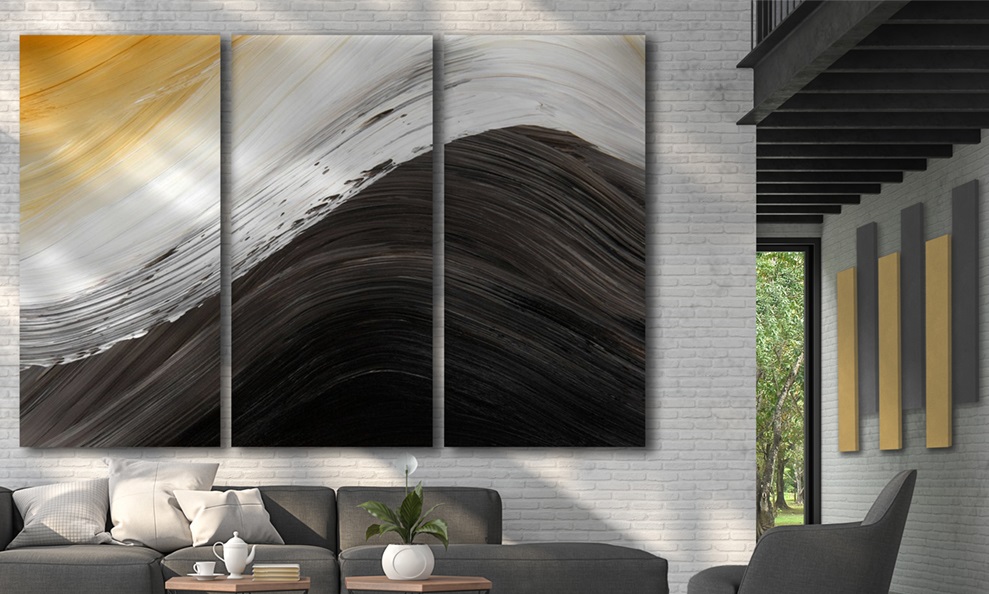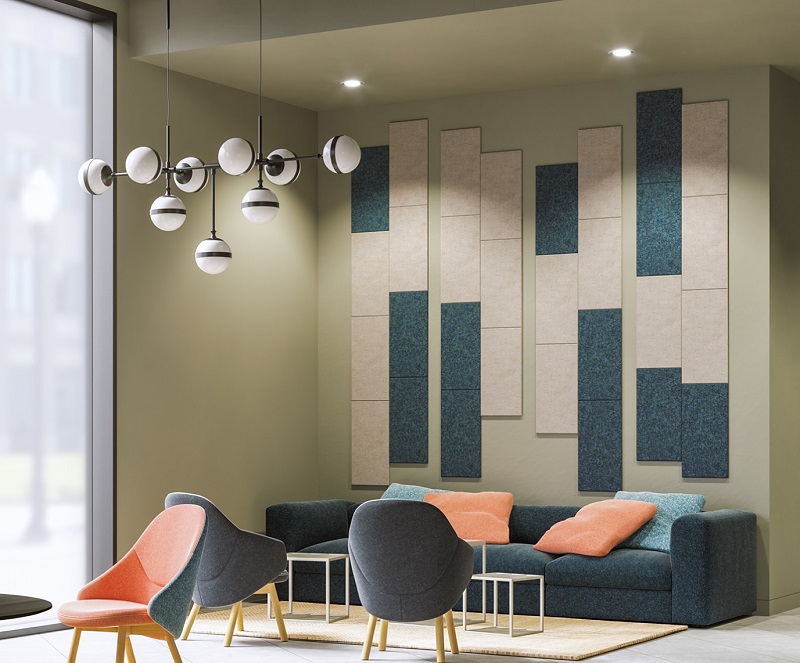Updated: August 15, 2023
The main photo is courtesy of Acoustimac which features an example of their AcousticART Multi-Panel Span acoustic wall panels.
Unwanted noise is just the latest consequence of spending more time at home in multifunctional spaces. This article explains how you can improve the sound of any room, with noise reducing acoustic panels to create distraction-free, productive indoor environments.
Table of Contents
- Why Improving the Acoustics of Your Home is Important
- Ways to Incorporate Acoustic Panels into Your Home’s Interior Design
- How to Choose the Right Acoustic Panels for Your Spaces
- Soundproofing vs. Sound Absorption: What’s the Difference?
- How to Mitigate Unwanted Sound
- What is Wall Cladding & Can It Improve Sound Quality?
- Products that Mitigate Unwanted Sound & Noise
- Tools to Help Choose Acoustic Solutions
- Acoustic Panel & Treatment Manufacturers
- Additional Soundproofing & Sound Reduction Products
- Concluding Remarks
Also see:
Why Improving the Acoustics of Your Home is Important
Though we are living in times necessitating highly functional, flexible interior spaces, these areas can become annoyingly noisy and acoustically off putting, especially when involving home office situations and virtual conference calls. If you haven’t yet thought about improving the acoustics of your home, now is a good time.
Unwanted noise and unpleasant sounds are just the latest consequence of spending more time at home in open multi-functional spaces: more people at home at the same time; more time on video conference calls; more time learning virtually; more time consuming media; and more time pursuing hobbies & interests at home, such as playing musical instruments.
Equipped with the right knowledge about materials, products and approaches, you can significantly improve the sound in any room, without significantly extending your budget. Noise reducing treatments can help to create distraction-free and productive indoor environments, similar to how commercial office spaces are acoustically optimized.
Where to Begin?
The best first step is to set proper expectations. To clarify, this article is NOT about Soundproofing but rather Sound Absorption. This is the practice of reducing unwanted noise and sound levels within a room, by preventing sound from freely “bouncing around” within the given space by absorbing sound waves.
Ways to Incorporate Acoustic Panels into Your Home’s Interior Design
Utilizing acoustic panels in interior design not only helps to create a quieter, more serene environment, but acoustic panels can also enhance the aesthetic appeal of your interior spaces. There are numerous methods to incorporate these panels into any design scheme, each of which can greatly aid in dampening noise and improving overall sound quality.
The following are the most effective ways to integrate acoustic panels into your interior design:
On the Walls
One of the most common placements for acoustic panels is on the walls. This method not only helps to absorb sound waves and reduce echo but also adds texture and interest to a wall. Panels are available in a variety of colors and finishes, allowing for a seamless integration into any design scheme.
As Ceiling Panels
Another effective placement for acoustic panels is on the ceiling, where they can mute overhead sounds and reverberations. This is especially useful in multi-story buildings or rooms with high ceilings where sound can easily bounce around. Additionally, ceiling panels can provide a unique design element, attracting the eye upwards and creating a sense of height and space.
Integrated Into Furniture
Acoustic panels can also be integrated into furniture, such as bookcases or room dividers. This approach not only helps to absorb sound, but also adds a functional and stylish element to the room. This method can be particularly effective in larger, open-plan spaces where sound is more likely to reverberate.
Using Acoustic Art
For those who wish to inject a little creativity into their space, acoustic art is an innovative solution. These are essentially acoustic panels disguised as artwork, allowing for effective sound absorption without compromising on style. They can be customized with any design or image, providing a personalized touch to any room.
How to Choose the Right Acoustic Panels for Your Spaces
Choosing the right acoustic panels for your space is an essential step in creating a serene and noise-free environment. With a variety of options available in the market, it can be somewhat challenging to select the most suitable type for your needs. However, understanding the basic factors to consider can significantly simplify this task.
- Identify the Source and Type of Noise
- Understand the Materials and Their Acoustic Properties
- Consider the Size of the Room
- Choose the Right Placement
- Consider the Aesthetic Appeal
Identify the Source and Type of Noise
The first step in selecting the right acoustic panels is to identify the source and type of noise you’re dealing with. This could be impact noise from the floor above, airborne noise from a nearby highway, or echo and reverberation within the room itself. The type of noise will determine the type of acoustic panel required.
Understand the Materials and Their Acoustic Properties
Acoustic panels are typically made from a variety of materials, each with its unique set of acoustic properties. Some materials are more effective at absorbing high-frequency sounds, while others are better at dealing with low-frequency noise. Common materials include foam, fiberglass, and mineral wool, among others.
Consider the Size of the Room
The size of the room is another crucial factor to consider when choosing acoustic panels. Larger spaces generally require more or larger panels to effectively absorb sound, while smaller spaces may require fewer or smaller panels. The panels should be spread evenly throughout the room for optimal sound absorption.
Choose the Right Placement
Placement of the panels is as important as the panels themselves. Panels should be installed at the points of first reflection, which are the spots where sound waves first hit after being emitted from the sound source. Common points of first reflection include walls directly opposite windows or doors, and the ceiling directly above the sound source.
Consider the Aesthetic Appeal
Lastly, while the primary function of acoustic panels is to reduce noise, they should also blend in with the room’s decor. Acoustic panels come in various colors, patterns, and textures, allowing you to choose one that matches your interior design theme.
By taking these factors into consideration, you can ensure that you choose the right acoustic panels for your space, effectively minimizing unwanted noise and enhancing the acoustic quality of your room.
Soundproofing vs. Sound Absorption: What’s the Difference?
Soundproofing is a method of keeping sound waves contained in a physical space while stopping unwanted sound from entering that same space. Soundproofing product effectiveness is measured in STC’s or Sound Transmission Class. STC is the most commonly used measurement for sound reduction and is an indication of how much sound a wall, barrier or material might stop from penetrating. An STC rating of 60 or higher would be considered excellent soundproofing.
Soundproofing is more applicable for Sensory Rooms, Rehearsal Studios, Media/Theater Rooms and maybe Bedrooms, if you are a light sleeper. This would involve more extensive and costly construction and should be considered only when you have the luxury of starting from the studs to design and construct adequate soundproofing. In short, the details and methods are absolutely critical to create a truly soundproofed environment.
Sound Absorption on the other hand, actually absorbs sound waves that bounce around in space and distort acoustics, create background noise or produce an unwanted echo. Acoustic sound absorption is measured in NRC (Noise Reduction Coefficient) on a scale of 0 to 1. A higher value indicates more sound is being absorbed. Sound Absorption will not completely stop sound from entering another room, but improves the sound quality of an enclosed space. It will also improve how you sound on your virtual conference calls.
GIK Acoustics: How to Improve Your Video calls with Acoustic Panels
How to Mitigate Unwanted Sound
Understanding how acoustics work is extremely important in controlling noise resonance and determining the proper material to fix your sound issues. Do you need to reflect, absorb or transmit the sound waves to achieve your goals? What types of acoustic solutions are available?
The Basics of Room Acoustics
Mass is the key factor for controlling sound waves or abating noise. The thicker or denser the insulation material the better it will absorb sound. Insulation stops the transfer of heat, cold and sound by trapping temperature and sound waves into the insulating material. It is important to note that different materials have different densities and will perform better than others.
Hard surfaces such as walls, ceilings and floors reflect sound waves which create an echo. Therefore to eliminate this property, you will need to absorb the sound waves that bounce off these hard surfaces. This is achieved by increasing mass or insulating with a thicker, denser product for sound absorption. The two most important factors are noise reduction and absorption.
What is Wall Cladding?
Architectural wall cladding is the application of any material over another material to provide a layer for thermal insulation, sound reduction, weather resistance, or aesthetics. The material used for cladding can be comprised of any material including stone, wood, brick composites, polymers, polystyrene or various blends of fibers.
Can Wall Cladding Improve Sound Quality?
Architectural wall cladding, specifically acoustic panels, has characteristics which can be ideal for noise absorption to help improve privacy and security, while providing a unique design aesthetic. In many instances the “cladding” material is specifically engineered to have sound absorbing properties, however there are other materials such as stone and timber that insulate sound naturally.
Given that wall cladding is a popular interior design treatment, be sure to check the noise absorption properties of any paneling under consideration, as hard surfaces may worsen your situation.
External noise from traffic or neighboring homes can be reflected away from your home to give a quieter interior. Equally, sound waves can be absorbed within a room to insulate noise from travelling to other parts of the home. Depending on how acoustic panels are used, you can create privacy zones or acoustic separations within your home for:
- Home Office Spaces
- Home Theaters
- Music Listening Rooms
- Music Rehearsal Spaces
- Recording Studios
- Bedrooms
- Sensory Rooms
- Library/Study Spaces
- Virtual Learning Spaces
Products that Mitigate Unwanted Sound & Noise
When addressing specific noise issues, it is recommended to take practical, incremental approaches and measure progress along the way. An example of this approach is first making sure that a space is adequately “furnished” to counter the effects of hard surfaces (e.g. exposed hard flooring, drywall and tiles), with soft surfaces, such as carpeting, rugs, furniture and plants. This can be deemed the baseline before adding acoustic wall coverings and other acoustic treatments.
Here are types of products to consider that may be well-suited for your specific sound reduction needs:
- Acoustic Insulation
- Acoustic Panels
- Bass Traps
- Desktop Module Kits
- DIY Acoustic Panel Kits
- Movable Panels (AKA Gobos)
- Room Dividers
- Wall Cladding
- Wall Design Packs
Tools to Help Choose Acoustic Solutions
Given that acoustic panels are widely considered to be highly effective at improving the acoustics of interior rooms, most of these tools and resources have to do with selecting acoustic panels for a given space.
- Acoustic Art Panel Editors
- Free Acoustic Advice Forms
- Acoustical Room Calculators
- Room Acoustic Visualizers
Acoustic Art Panel Editors
Several leading manufacturers of acoustic panels offer the ability to create custom graphic prints. The process can entail some or all of these options: selecting orientation & dimension, thickness, insulation type, fabric, and spanning the graphic image across multiple panels (AKA multi-panel span or stack).
Free Acoustic Advice Forms
If you are addressing more complex noise issues, several leading acoustics-related websites have Free Advice Forms that will provide expert feedback and suggestions based on your unique situation and needs.
Acoustical Room Calculators
If you are leaning towards adding acoustic panels to a room, these two calculators will give you a quick overview of the likely number, size and cost of the panels adequate for a given room size.
Acoustimac has a quick and easy Acoustical Room Calculator to estimate the number of acoustic panels and sizes for rooms with ceilings of 13 feet or lower.
Audimute’s Acoustic Panel Room Calculator provides min and max panel recommendations across three treatment scenarios:
- Standard Treatment (e.g. offices)
- High-Intensity Treatments (e.g. recording studios and home theaters)
- Light Treatments (e.g. living rooms)
Room Acoustic Visualizers
GIK Acoustics has a free Room Acoustic Visualizer tool that allows you to create a 3D rendering of the space you are optimizing, with the ability to place GIK Acoustics products inside. If you plan to save or share your plans, you will need to create a free login account. The tool has several templates to start your design with, as well as several training videos to help you quickly get familiar with key features.
Acoustic Panel & Treatment Manufacturers
The following vendors offer a wide-range of acoustical products that can help address your specific sound issues, including a variety of different aesthetic treatments and options to match any design style.
- Acoustical Solutions
- Acoustimac
- Audimute
- GIK Acoustics
- Guilford of Maine
- Qwel Designer Acoustic Tiles
Acoustical Solutions
Acoustical Solutions, in operation since 1989, is a leading provider of acoustical products used in architectural and industrial applications throughout the world. They serve a wide-range of customers including: end-users, contractors, AV integrators, architects, designers, acoustical consultants and DIY’ers. Products offered of most relevance to residential applications include:
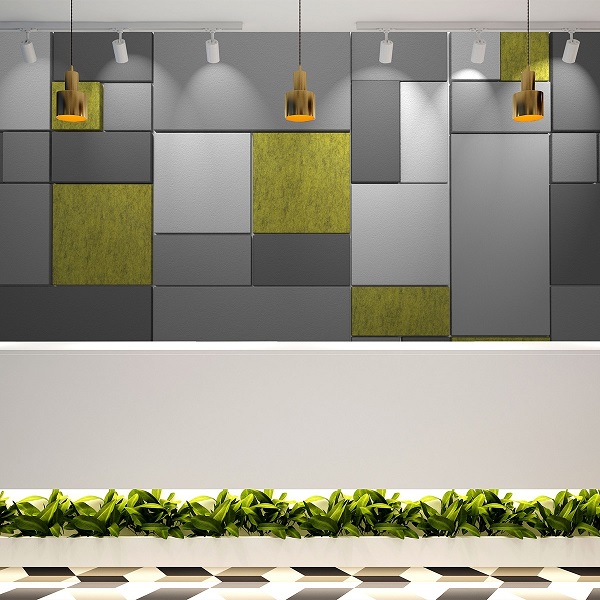
Acoustimac
Acoustimac specializes in making affordable acoustic treatments that work. Besides offering custom-designed acoustic panels, they also carry a large assortment of DIY acoustical materials, colors and designs for a wide range of applications. Their Acoustic Room Calculator is a quick and easy way to get an automated estimate of recommended acoustic panels based on the dimensions of a room.
Products offered of relevance to residential applications include:
They also have an easy approach to span a graphic image across multiple panels, called Multi-Panel Span and Multi-Panel Stack, depending on the orientation.
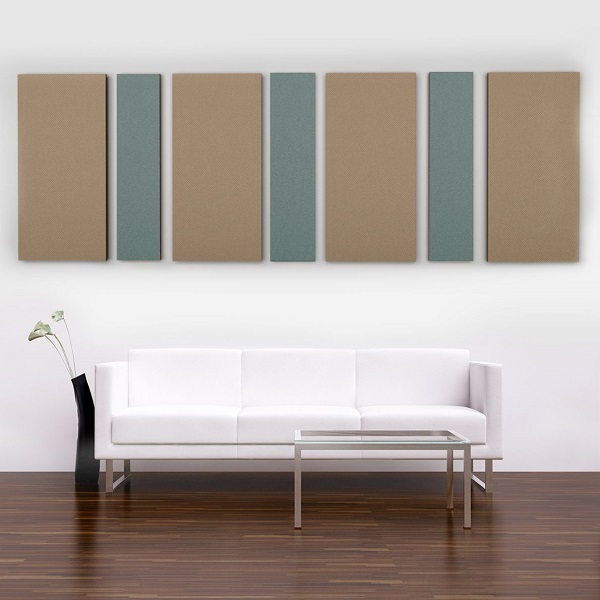
Audimute
Audimute’s reputation as an innovator in the acoustics industry stems from its Founder and President, Mitch Zlotnik. Years ago, before founding the company, he desperately needed soundproofing to keep the “peace” in his household while he played his drums.
Audimute’s mission has since grown to improve the varied acoustic spaces of their customers, with a tagline that is aptly “Volume Control for the Real World”. The core technology of their acoustic panels is eco-C-tex®, an innovative, eco-friendly acoustical absorption material made of recycled cotton and cellulose.
For those considering wall cladding, be sure to check out their AcoustiWood wood-alternative panels that are a highly effective sound absorption solution that resembles real wood. The panels are made of eco-C-tex® and the surface is a graphic printed on acoustical fabric. They also have a diverse set of creative acoustic panel offerings.
Audimute Before-After Treatment
GIK Acoustics
GIK Acoustics excels at providing solutions and products for recording studios, listening rooms, home theaters, restaurants, churches, and live auditoriums.
They build every acoustic panel by hand and tout that dollar for dollar, GIK Acoustics’ products absorb more sound than any other product on the market.
Besides having a large staple of fabric wrapped acoustic panels, they also offer the uniquely stylish Impression Series of panels that bring elegance to any room whether in a home, business, restaurant, or recording studio.
Other product categories that set them apart include:
They also provide very helpful, easy-to-understand video content that demystifies the intimidating subjects of sound dynamics and room acoustics.
GIK Acoustics Treated vs Untreated Room
Guilford of Maine
Guilford of Maine manufactures high-performance textile solutions for acoustical and multipurpose applications.
Their acoustic fabrics are optimized to look great, while letting sound pass through to the underlying acoustic panel, which does the actual sound absorbing. The key technical trait of their acoustic fabric is High Acoustic Transparency, which makes it ideal for music studios and home theaters.
The FR701 fabric line has been their most popular acoustic fabric for over 40 years, in terms of performance and aesthetics, and is offered in over 62 different colors. Their fabrics are available through leading manufacturers of fabric covered acoustic panels, as well.
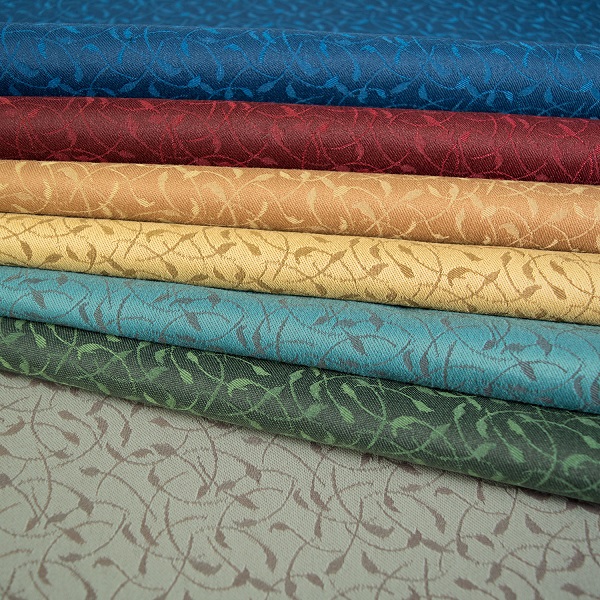
Qwel Designer Acoustic Tiles
We first learned of Qwel at IBS 2023, when we experienced their innovative and highly effective acoustic technology firsthand in a noisy and crowded exhibition hall at the Las Vegas Convention Center.
Launched in January 2023, Qwel Designer Acoustic Tiles take a sustainable approach to noise reduction and dampening. Their tiles are constructed of PET (polyethylene terephthalate) fibers and other recycled materials to provide an eco-friendly sound dampening solution that is easy to install.
Qwel’s acoustic wall tiles are available in the following shapes:
Qwel’s acoustic ceiling tiles are available in the following designs: Flat; 1/4″ Drop; Wedge; 1″ Drop; Linear Wave; Deep Dish; Recessed Square; and Quad Circle.
Their wide selection provides ample flexibility to meet a wide-range of acoustical challenges and design requirements.
Additional Soundproofing & Sound Reduction Products
- Acoustiblok® Soundproofing Material
- Green Glue Noiseproofing Compound
- Indow Windows Noise Reduction Window Inserts
- Owens Corning 703 Insulation for Acoustic Panels
- QuietRock Sound Reducing Drywall
Commercial Acoustic Products & Inspiration
Additional Information on Sound Reduction & Sound Proofing
- Acoustiblok® Creates Sensory Room for Family with Autistic Child
- Soundproofist Noise, Sound & Acoustical Resources
Concluding Remarks
As homeowners strive to achieve more convenient functionality from their existing square footage, acoustic panels can play an important role in this quest.
Incorporating acoustic panels into your interior design can significantly improve the acoustic quality of your space, while also offering a host of design possibilities. Whether you opt for wall panels, ceiling panels, integrated furniture, or acoustic art, these additions can help create a more peaceful and comfortable environment for a wide range of uses by a number of people.
Related Interior Design Articles
- Never Thought You’d Live in a Multigenerational Home? Think Again!
- How to Apply Transformable Interior Design to Your Home
- Hidden Doors: A Secret Example of Transformable Design
- Flexibility: The Only Home Design Trend that Matters
- Why You Should Apply Cinematically Inspired Design to Your Home
- 5 Stylish Ideas to Make Your House Look New & Feel Like Home
- 7 Tips on How to Make Your Home Up-to-Date & On-Trend
| Purgula is reader-supported. When you click on links to other sites from our website, we may earn affiliate commissions, at no cost to you. If you find our content to be helpful, this is an easy way for you to support our mission. Thanks! Learn more. |

